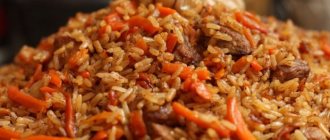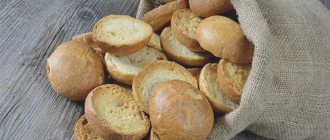Compound
On the left is raw green buckwheat; on the right - heat-treated brown buckwheat kernels
It’s difficult to call a raw product tasty, but it’s certainly possible to call it healthy. A tiny grain contains a lot of substances that the human body needs every day. The composition contains 2.5% fat, 15% protein, 62% carbohydrates, 1.3% fiber. The energy value of 100 g of product is 330 kcal.
| vitamins | Contents of 100 g of green buckwheat |
| A | 6 mcg |
| IN 1 | 0.4 mg |
| AT 2 | 0.2 mg |
| AT 6 | 0.4 mg |
| AT 9 | 31.8 mcg |
| E | 6.7 mg |
| RR | 4.2 mg |
| minerals | |
| Calcium | 20.7 mg |
| Magnesium | 200 mg |
| Sodium | 3 mg |
| Potassium | 380 mg |
| Phosphorus | 296 mg |
| Chlorine | 34 mg |
| sulfur | 88 mg |
| Iron | 6.7 mg |
| Zinc | 2.05 mg |
| Iodine | 3.3 mcg |
| Copper | 640 mcg |
| Manganese | 1.56 mg |
| Fluorine | 23 mcg |
| Chromium | 4 mcg |
| molybdenum | 34.4 mcg |
| cobalt | 3.1 mcg |
| silicon | 81 mg |
The table clearly demonstrates that by adding green buckwheat to your diet, you can reduce the intake of synthetic vitamins, unless they were prescribed by a doctor for therapeutic purposes.
The vegetable protein contained in green buckwheat has the same properties as animal protein; it contains lysine and 8 essential amino acids.
Useful and healing properties
The protein contained in green grains can be compared in nutritional value to the protein of a chicken egg. Therefore, their use is indicated in vegetarian diets. Another property of protein has been studied by Chinese scientists. This has an anti-cancer effect. Cancer patients are recommended to include sprouted green buckwheat grains in their diet.
Buckwheat is the only grain that does not contain gluten. This substance tends to be deposited in the intestines and slow down its work. That's why green buckwheat is a real treasure for people suffering from constipation, intestinal obstruction or gluten allergies. A large amount of coarse fiber helps cleanse the body and normal intestinal activity.
Green buckwheat is not subjected to heat treatment, so all vitamins and minerals are preserved unchanged. Iron, copper and cobalt are minerals involved in hematopoiesis and help maintain normal hemoglobin levels. The presence of strong antioxidants in the grains makes buckwheat indispensable not only for health, but also for beauty.
The polyunsaturated fats omega-6 and omega-9 contained in the product promote healthy blood vessels and the heart. For diabetics, buckwheat can replace bread and potatoes. It contains complex carbohydrates, which determines long absorption and the absence of sudden surges in blood sugar. This same quality makes buckwheat an important product in weight loss diets.
Eating green buckwheat is recommended in the following cases:
- to cleanse the body in case of blood diseases;
- as part of the nutrition of cancer patients;
- for diabetes and obesity;
- for ulcers in the stomach and intestines, thanks to its wound-healing effect;
- to increase potency;
- for hypertension and vascular diseases;
- to reduce intraocular pressure in simple glaucoma;
- with damage to the kidneys and liver;
- for diseases of the bronchi, thyroid and pancreas.
Buckwheat has never been bred to increase its resistance to pests and weeds. She simply did not need it, just like fertilizers. Therefore, we can safely talk about it as an environmentally friendly product.
Directions for use and application
Green buckwheat can and should be eaten raw. This is the whole point of using it for medicinal and simply health purposes. It is being germinated. A tiny sprout that hatches from a grain has enormous vitality and a supply of energy, which it gives to our body when it is consumed as food.
After 12 hours of germination, small sprouts appear from the kernels - buckwheat is ready to eat
It’s not difficult to prepare green buckwheat; you just need to soak it for a few hours. There are two ways to do this.
- The required amount of grains is soaked in cold water for two hours. Then they are washed, since the water becomes cloudy from the mucus with an unpleasant odor formed (there is no need to fill it with water again). The kernels are left moist with the lid slightly moved for 7 - 8 hours. After this, you can notice that the excess moisture has evaporated, and sprouts have appeared from the grains. Buckwheat is ready to eat.
- Rinse the grains and remove anything that floats to the surface. Place the buckwheat in a colander on a layer of gauze, cover with the same on top. Rinse the cereal well again through cheesecloth. Leave to germinate for 8 hours, then rinse again with water and set aside again for 6 hours. After this time, transfer the already sprouted buckwheat into a container and rinse with water to remove foam and mucus.
Now you can eat it. The sprouts have a delicate taste, slightly reminiscent of seeds. You can season a portion of buckwheat with vegetable oil and add a little salt, and also add it to salads.
Sprouted cereals do not store well, so it is better to cook them before use.
Raw foodists love buckwheat very much; it gives the body something that they cannot get if they exclude meat products from the diet. Here are some simple recipes for raw foodists.
You will need 1 cup of sprouted buckwheat and an amount of tomatoes to taste. Wash the green buckwheat soaked overnight, cut the tomatoes into cubes, mix everything and season with sesame oil and lemon juice. Salad ready.
tomatoes, green buckwheat and sesame oil - taste and benefits without harm to the body
Place green buckwheat flakes (amount to taste) in a blender along with chopped pieces of pear and ginger root. Grind everything with the addition of a small amount of water. The resulting mixture can be seasoned with your favorite nuts and dried fruits or berries.
The benefits of buckwheat kernels for the health of the body
Traditional medicine has been accumulating medicinal recipes for centuries. And they were all based specifically on green buckwheat, because there was no other one.
Heat treatment of cereals began to be done only in the 50s of the twentieth century.
To prevent vascular diseases and treat atherosclerosis, buckwheat jelly is prepared. To prepare it, grains are ground to flour. 2 tablespoons per glass of water is enough. The jelly is brought to a boil and cooked for several minutes over low heat. Regular consumption of the drink, 2 times a day, 200 ml, significantly alleviates the condition of illness.
By eating a teaspoon of green buckwheat flour 3 times a day, you can get rid of constant heartburn.
To increase hemoglobin, green buckwheat can be combined with honey and nuts. Sprouted cereals, liquid honey and walnuts should be taken in equal proportions. Grind the grains into flour, nuts into small pieces or flakes. Mix everything with honey and take a tablespoon per day.
Due to the anti-inflammatory properties of buckwheat, it is recommended to be consumed during an exacerbation of pancreatitis. It is accompanied by severe pain, which buckwheat will also help relieve. In the first days of illness, buckwheat can only be consumed in the form of porridge. To prepare it, the grains - about a glass - must be thoroughly rinsed and filled with water so that it covers the grain by 2 - 3 cm. Cook over low heat until a viscous porridge forms (about 15 minutes). You need to eat it without salt and oil. This porridge will help stop pain and inflammation. Then you can eat buckwheat with kefir. This will help to completely relieve the exacerbation of pancreatitis and cleanse the body well.
It only takes 15 minutes to prepare porridge from buckwheat kernels, but it will bring so many benefits to the whole body
Green buckwheat during pregnancy and breastfeeding
Eating green buckwheat during pregnancy is an excellent way to maintain immunity, normal metabolism and provide yourself and your developing baby with a balanced complex of vitamins and minerals. Folic acid is necessary for pregnant women for the proper formation and development of the fetus.
While carrying a child, weight gain is inevitable. If the doctor determines the presence of extra pounds, then you need to get rid of them, but not in the name of a slim figure, but to preserve the health of yourself and your child.
You can do fasting days during pregnancy only with the permission of your doctor!
As a general tonic, buckwheat can be introduced into the daily diet in small quantities. It can be sprouted and eaten little by little with butter and salt, or added to salads and simply chewed. By the way, in this form it will save you from heartburn, which often torments pregnant women.
For fasting days, porridge is prepared from green buckwheat. At night, 1 glass of grain is washed, placed in a thermos and filled with hot water. In the morning you get ready-made porridge. It is divided into 5–6 servings and eaten throughout the day. You can alternate porridge with apples or kefir if desired. On a fasting day, you need to drink plenty of water - 2-3 liters of water.
During breastfeeding, the composition of the mother's diet is very important. What she eats, her child also eats. Buckwheat is perfect for their balanced diet. It helps maintain immunity, which a nursing mother gives to her baby through breast milk. With it, all the necessary vitamins and minerals enter the body. In addition, green buckwheat is a product that will help a woman lose excess weight after childbirth and strengthen hair and nails weakened during pregnancy.
Physical activity while breastfeeding
During intense training, lactic acid accumulates in the muscles, which passes into breast milk. This may cause the child to refuse breastfeeding. Exercise immediately after your baby eats or 1.5 hours before the process. The best types of physical activity while breastfeeding:
- Walking. When walking with your baby, do not sit still, but walk at a fast pace for at least 40 minutes.
- Yoga. All asanas are performed smoothly, thanks to which fatigue will go away quickly and will be replaced by relaxation.
- Swimming. Excellent tonic and uplifting. Replaces wraps, which are not recommended during lactation. Eliminates cellulite, tightens skin, ensures healthy weight loss.
- Natural loads. Little children love to jump on a fitball with their mother, fly on their hands, and dance. Be physically active with your baby.
DETAILS: Duovit for men - official instructions for use, analogues
Green buckwheat in a child’s diet
The benefits of buckwheat porridge for young children have long been known. It can be replaced with green buckwheat. The taste is different, but if you immediately introduce such cereals into a child’s diet, the child will get used to it and will not refuse it. Everything contained in it is necessary for the child’s body. In addition, many children are allergic to gluten, which is absent in green buckwheat.
For older children, sprouted grains can be given a little (about a teaspoon) every day as a vitamin supplement.
You need to cook or steam the porridge with water and give it to the child without adding milk, since the combination of buckwheat with milk slows down the absorption of nutrients and can cause constipation and flatulence in the child.
Some tips
When buying buckwheat, inspect it carefully. The color should be light, with a greenish tint. Please note the date of manufacture. The shelf life of green buckwheat ranges from 6 to 20 months. Store buckwheat in a closed glass container or in a linen bag in a dark, ventilated place.
Don't be afraid to cook green buckwheat. If this is done correctly, it does not lose its healing and beneficial properties.
If after the first use of the product you feel discomfort in the intestines, this is normal; cleansing of the body begins.
If you want to preserve beauty, health and youth, replace regular buckwheat with green buckwheat and eat it raw. It is useful for people of any age. The main thing is to remember that any product is good in moderation.
Why the buckwheat diet is not recommended by doctors
Most new mothers, after being discharged from the hospital, are faced with the problem of excess weight and try in every way to lose it. The buckwheat diet is one of the most popular. Its essence is to consume buckwheat every day for 7-14 days, which is poured with boiling water in a 1:2 ratio in the evening and covered with a lid.
The next morning, the cereal becomes soft and can be consumed without pre-cooking. Along with such porridge, the diet should include green apples, low-fat kefir and, of course, a large amount of water (about 2 liters per day). But doctors do not recommend going on a buckwheat diet while breastfeeding.
Any nursing mother should consume 600 calories more per day than before giving birth. Thus, the daily requirement for a young mother should be 2500 calories. At first glance, it may seem that everything fits, because 100 g of buckwheat porridge contains 300 calories, and you are allowed to eat 1 kg of buckwheat per day.
However, when breastfeeding a child, a woman needs to monitor the amount of nutrients she consumes. Buckwheat, although it has a good composition, cannot independently provide a nursing mother with all the necessary vitamins and minerals.
Along with such porridge, it is recommended to eat a moderate amount of meat, a lot of fruits and vegetables, which are incompatible with the buckwheat diet, since it involves eating only buckwheat, kefir and apples.
Proper nutrition during breastfeeding
How can a nursing mother lose weight if she constantly wants to eat? Eat healthy! However, your menu should include simple foods. The daily calorie intake during breastfeeding is approximately 2000 kcal. Dishes should be boiled, baked or stewed. Proper nutrition during breastfeeding for weight loss involves 5-6 meals. Avoid extreme hunger pangs. Always keep a glass of yogurt, kefir or fermented baked milk on hand - they will dull your appetite.
DETAILS: Is it possible to lose weight on bread. How to lose weight with bread. Rules for eating bread.
Losing weight with a full breastfeeding child is effective when there is a sufficient amount of protein and vegetables in the diet. Energy costs are compensated by complex carbohydrates - porridge, whole grain bread. It is very important for a nursing mother to drink plenty of fluids to lose weight and have good lactation. Preferably water, mineral water without gas. Be careful with green tea, compotes, and fruit drinks.
Buckwheat recipes for a nursing woman
Before you start cooking from buckwheat, you need to clear it of unopened grains, if any. You should also rinse with boiling water until the water becomes clear. This is done in order to wash away dust and all kinds of chemicals that are used to treat cereals during storage in warehouses for better preservation, as well as to protect them from rodents and other pests.
To prepare buckwheat porridge you need:
- One glass of buckwheat.
- Two glasses of water.
- Pour water into the pan, add buckwheat, stir, cover with a lid and put on fire.
- Lightly salt the water. You can do without salt.
- When the water boils, the fire must be switched to minimum power.
- Remove from heat when the cereal has completely absorbed the water.
- Take a towel and wrap it around the pan.
- Leave for 15 minutes.
The consumption of salt and sugar, especially in the first 6 months of breastfeeding, should be limited. You can add a piece of butter or a couple of drops of vegetable oil to the finished porridge. You can take it as a side dish to boiled vegetables, lean meat and fish.
To prepare buckwheat soup you need:
- Chicken or beef low-fat broth.
- Finely chopped potatoes.
- Finely chopped onions.
- Buckwheat.
- Green dill.
- A pinch of salt.
Add onions, buckwheat and potatoes to the boiling broth. When they are almost ready (semi-hard), you need to add dill and cook until fully cooked.
The multicooker is becoming more and more common among young women. This is a kind of kitchen assistant that saves housewives time.
To prepare porridge with chicken, you will need:
- 1 glass of buckwheat.
- 2.5 glasses of water.
- 100 grams of finely chopped chicken fillet.
- Half a head of finely chopped onion.
- 2 tablespoons of vegetable oil.
- Salt to taste.
Very often, before cooking buckwheat, I fry it for a couple of minutes in a dry frying pan. This gives an unusual taste and aroma to the finished dish.
Having studied forums for mothers about the dangers and benefits of buckwheat porridge during breastfeeding, I came to the conclusion that most breastfeeding women use cereal for the purpose of losing weight, and not to maintain the immune system and quickly restore the body and replenish vitamins after childbirth.
Even though buckwheat has a large amount of useful substances and vitamins, its thoughtless consumption in large quantities during lactation can cause negative reactions from the baby.
Buckwheat in the diet of a nursing mother
Buckwheat is a cereal and honey-bearing herbaceous plant of the Polygonaceae (Buckwheat) family. We eat its seeds - this is buckwheat or buckwheat, buckwheat. The culture came to us from Nepal and Northern India, where it has been grown for more than 5 thousand years and is called “black rice”.
Buckwheat is an unpretentious plant, it is not treated with chemicals against pests, and therefore buckwheat can be considered safe and environmentally friendly
On sale you can find:
- whole buckwheat grain - core;
- done - crushed kernels (during crushing, the structure of the grain is disrupted);
- Smolensk groats - highly crushed kernels.
Groats made from whole buckwheat grains (kernels) retain the greatest amount of useful substances during cooking, compared to prodel and Smolensk groats.
Buckwheat porridge, cooked from whole buckwheat grains, is considered the healthiest - it retains the greatest amount of nutrients. In crushed cereals, the active elements disintegrate or change under the influence of air, causing some of its beneficial properties to be lost. The smaller the grain, the less vitamins it contains.
This is what green buckwheat looks like - it is healthier than brown (fried) buckwheat
To improve the taste of buckwheat, the grains are fried before cooking. Again, under the influence of high temperature, some of the vitamins in it are destroyed. Therefore, the benefits of unfried, green buckwheat will always be greater.
In the diet of a nursing mother, buckwheat occupies a key place of honor, due to the fact that it is an extremely healthy, hypoallergenic, dietary product. When breastfeeding 2 or 3 times a week, buckwheat dishes can be included in a woman’s menu. Groats are added to soups and casseroles, porridge is cooked from it, and delicious pancakes are prepared from buckwheat flour. How to cook buckwheat porridge correctly?
Boiled porridge
To ensure you get tasty, healthy, crumbly buckwheat, when preparing it, be sure to follow the proportions of adding water and cereal. It is optimal to take 2 parts of water for 1 part of cereal (kernels). As you introduce vegetables (zucchini, cauliflower, carrots) and fruits (green apples, pears, bananas, dried fruits) into your diet, they can also be added to porridge. But use sugar and salt very sparingly.
Cook the buckwheat covered, so it will steam well and be soft and crumbly.
Ingredients:
- buckwheat - uncrushed (fried will be more flavorful, unfried is healthier) - 1 tbsp. (210 g);
- water - purified, artesian, boiling water - 2 tbsp. (400 ml);
- butter - 72.5% fat content - ½ tsp;
- table salt - ½ tsp.
Preparation.
- Measure out the required amount of cereal, sort it thoroughly, rinse with cold water and dry a little.
- Melt the butter in a saucepan with a thick bottom and walls.
- Add buckwheat and salt there and mix well so that each kernel is covered with a thin oil film.
- Pour boiling water over the cereal and place on low heat.
- Cover the pan tightly with a lid and simmer the porridge for 20 minutes. Do not open the lid and do not stir the porridge.
This porridge is more useful, as it retains more vitamins. It turns out tasty and crumbly. And it's very easy to prepare.
It is very convenient to steam buckwheat porridge in a thermos
Ingredients:
- buckwheat (kernel) - it should first be sorted and washed - 100 g;
- water - purified, boiling water - 200 ml;
- salt - ¼ tsp.
Preparation.
- Place washed and dried buckwheat into a saucepan.
- Pour boiling water over the cereal and add salt.
- Cover tightly, wrap and leave warm overnight.
- In the morning the porridge will be ready to eat. You can fill it with butter or vegetable oil.
Buckwheat diet during pregnancy reviews
Any diet during pregnancy and breastfeeding involves the use of foods that are healthy for the mother and her baby.
At this time, representatives of the fair sex sometimes choose mono-diets that quickly burn fat and help normalize weight.
One of the most effective and safest is the buckwheat diet for pregnant and lactating women, so we will tell you about it.
The buckwheat diet during breastfeeding and pregnancy has a beneficial effect on the mother’s digestive system, removing toxins and waste from the body. You can combine cereals with drinks: milk, kefir, tea, mineral water.
To ensure that the buckwheat diet during pregnancy and breastfeeding brings positive results and does not harm you, follow certain rules:
- do not add salt, sugar or spices to the porridge;
- have dinner three hours before going to bed (if the feeling of hunger is very strong, drink kefir);
- Talk to your doctor and find out which multivitamins you can take while on a diet.
The basic rule is related to the correct preparation of cereals. Buckwheat should not be cooked in the traditional way, but should be poured with boiling water in a ratio of 1 to 2 and left to swell overnight. During the day, during the buckwheat diet during breastfeeding or pregnancy, you should drink a liter of kefir, unsweetened tea and mineral water. Add unsweetened fruits, cottage cheese and low-fat yogurt to your diet.
Do not forget, buckwheat porridge with a small additional set of products will not be able to supply your body with the necessary vitamins and minerals that are needed for normal fetal development. You definitely need to start taking a vitamin complex. Find out which multivitamins are best for pregnant women in our other article.
Many experts do not recommend mono-diets for weight loss during pregnancy, and during breastfeeding, a buckwheat diet is your personal choice. Please note that you will have significantly less strength and energy than with a normal, complete diet.
Do not start a buckwheat diet during pregnancy or breastfeeding if you have gastrointestinal diseases, ulcers, gastritis and pancreatitis, otherwise you will worsen the situation.
The health of your unborn baby depends on the correctness of your diet. The question often arises: is it ok to eat buckwheat during pregnancy? The use of this product is of great importance. This cereal contains a huge amount of vitamins that are important for the health and proper formation of the embryo.
The benefits of buckwheat during pregnancy lie in its rich composition:
- Rutin. This is one of the important elements of buckwheat. It helps strengthen the blood vessels of a pregnant woman and maintains their elasticity. Thanks to the action of rutin, blood pressure is normalized, which, from time to time, may increase;
- Lipotropic substances. Helps protect the liver and strengthen the cardiovascular system;
- Folic acid. It is an important element that prevents the appearance of congenital defects in the fetus;
- Amino acids. Threonine and tryptophan, found in cereals, help maintain acid-base balance and speed up metabolism in your body;
- Iodine. Helps strengthen the immune system during pregnancy;
- Iron. Helps reduce the risk of anemia, which can occur in pregnant women and is detected by taking the necessary tests (Read the current article: What tests are taken during pregnancy?
After the birth of the baby, the young mother tries to create a daily diet in such a way that the foods she eats benefit her and also have a positive effect on lactation. Only fresh and healthy food can make breast milk the most nutritious. An excellent option would be buckwheat, which contains valuable protein and vitamins, but most importantly, it is completely hypoallergenic.
Buckwheat diet during breastfeeding
During pregnancy, mothers rapidly gain weight, which is then difficult to lose. Pediatricians do not recommend going on a diet during lactation, as this can lead to a lack of nutrients in the body. But many mothers note that the buckwheat diet they followed during breastfeeding helped them lose extra 5-9 kg.
It consists of the following: 1 tbsp. cereals pour 2 tbsp. boiling water, cover with a lid and leave to swell overnight. Over the next day, they eat steamed cereal, which they alternate with green apples and low-fat kefir. Additionally, drink at least 2.5 liters of water per day.
Important! Going on a diet before the child reaches 6 months of age is strictly prohibited. It is worth considering that the buckwheat diet is monocomponent and limits the variety of substances entering the body. If your milk volume decreases, you should immediately switch to a normal diet.
During lactation, a nursing mother loses about 600 kcal daily, since milk production is a very energy-intensive process. Therefore, even without a diet, significant weight loss and rapid weight loss occur.
Beneficial features
Undoubtedly, buckwheat is considered one of the most affordable and healthy foods in our country. In order to get exceptional benefits from eating dishes made from this cereal for yourself and your baby, it is important to prepare it correctly, while preserving the entire range of useful elements.
Doctors recommend that breastfeeding women include this cereal in their diet as early as possible. This is explained by the fact that it is well absorbed and does not cause an allergic reaction, which is an important point during breastfeeding. Everything the mother eats affects the taste and quality of the milk, which is the only source of nutrition for the baby at first.
In the first month after childbirth, it is recommended to eat buckwheat porridge as a main dish. In addition, doctors advise introducing a child to this cereal as a first complementary food. Hypoallergenic and healthy porridge will have a positive effect on the growth and development of the child's body.
To be convinced of the value of buckwheat for breastfeeding, it is necessary to present its beneficial qualities.
- The absence of gluten makes the cereal completely hypoallergenic and therefore safe for newborns.
- Due to the easy digestibility of the product, useful components in the right quantities are absorbed into the blood.
- Buckwheat undergoes special processing without the use of chemicals and genetic modifiers. Therefore, it is absolutely safe for babies and women during pregnancy and breastfeeding.
- The high iron content in the grain kernel is superior to other cereal crops. Therefore, this product can prevent the development of anemia in a woman after childbirth.
- The presence of calcium has a positive effect on the growth and strengthening of bone tissue. The postpartum period is often marked by hair loss, peeling nails and poor dental health - all due to a lack of calcium.
- The functioning of the nervous system is normalized, which helps get rid of depression. In addition, it has a beneficial effect on the development of the child’s psyche.
- Digestion is noticeably improved.
- All metabolic processes are launched due to the available macroelements.
- Hormonal levels stabilize.
- Buckwheat provides cholesterol removal.
- The walls of blood vessels and the heart are strengthened.
- A high level of fiber will relieve a woman of intestinal problems - constipation, gas and flatulence.
- The ban on eating raw vegetables and fruits causes a deficiency of vitamins, so buckwheat can fully compensate for it.
- The protective functions of the immune system are enhanced.
- The processes of hematopoiesis and blood circulation are normalized.
- The functioning of the liver and kidneys is regulated.
- Blood sugar levels are controlled.
- Blood pressure stabilizes.
- The cleansing effect rids the female body of waste, toxins and excess fluid.
- A diuretic effect is noted.
- Regular use enhances lactation.
- Eating buckwheat as the main food during breastfeeding increases the nutritional value and benefits of breast milk.
Can buckwheat be harmful?
Buckwheat is considered one of the most hypoallergenic and safe cereals. When growing it, no herbicides or other chemicals are used, because buckwheat itself displaces weeds from the field.
An allergy to buckwheat in an infant is an extremely rare phenomenon. As a rule, it is well accepted by babies and does not cause digestive problems. Usually, buckwheat does not cause negative reactions even among allergy sufferers, so mothers of such children often have to go on a buckwheat diet, excluding more dangerous cereals from the menu.
It is not recommended for nursing mothers to use buckwheat for weight loss, as a mono-diet. The period of breastfeeding is generally not suitable for strict and not very strict diets, since they are poorly adapted to the requirement to eat a nutritious and balanced diet.
DETAILS: Chicken broth on a diet - Health Info
Despite all the beneficial properties, a nursing mother should first consult with a doctor about introducing the product into the diet if:
- food allergies and individual intolerances;
- chronic renal and liver failure;
- stomach and duodenal ulcers;
- exacerbation of gastritis or pancreatitis;
- increased blood clotting.
Contraindications and harm
Despite the fact that this cereal has many beneficial qualities, doctors have identified several contraindications for use during breastfeeding.
You should avoid consumption if you have the following diseases:
- renal failure;
- vegetative-vascular dystonia, in other words - pressure surges;
- diabetes;
- hypertension due to the product's ability to dilate blood vessels.
During lactation, you should consume buckwheat no more than 3 times a week in small portions - 200 grams is enough. Overeating will only harm the mother's body.
Doctors recommend alternating cereals with other cereals. A monotonous menu is considered less useful during this period.
Allergies in infants are excluded if the daily intake of cereals is observed.
Useful properties of cereals
Buckwheat can be stored for a long time without losing its qualities. At high humidity, it does not become moldy or bitter - this is its huge advantage compared to other cereals.
Buckwheat during lactation:
- strengthens the immune system, promotes the absorption of vitamin C in the body;
- improves digestion, normalizes appetite and intestinal microflora, helps get rid of constipation;
- gives a feeling of fullness for a long time, and does not cause excess weight gain;
- activates metabolic processes, regulates blood sugar and cholesterol levels;
- promotes tissue regeneration, reduces vascular permeability;
- normalizes blood pressure, reduces swelling, supports the functioning of the heart muscle;
- prevents the development of iron deficiency anemia, improves blood circulation;
- stimulates the function of the thyroid gland and liver, removes toxins from the body;
- improves the condition of the skin, the appearance of hair, and the structure of nails;
- strengthens teeth and gums, relieves inflammation;
- activates mental activity, stabilizes hormonal levels;
- calms, improves mood.
Features of use
A nursing mother should take care not only about choosing fresh and healthy foods, but also about the method of preparing them. The fact is that improperly prepared ingredients lose their valuable substances, as a result of which the food becomes almost empty.
During the breastfeeding period, it is recommended to use buckwheat as a side dish for meat, fish and vegetable components, milk buckwheat porridge (with or without sugar, honey), and buckwheat soup.
Cereals cooked in milk are considered a particularly healthy dish. Its use can enhance the lactation process, especially if there is a lack of breast fluid.
Some people prefer to fill buckwheat grains with raw milk. Doctors do not recommend using this method of preparation when breastfeeding - the raw component may cause an allergic reaction and intestinal colic in the baby.
Buckwheat soup is a very satisfying and nutritious dish that is beneficial for mother and child. You can add fresh or frozen vegetables and lean meat to its composition.
Properly prepared buckwheat dishes will be an excellent source of nutrients for women during breastfeeding.
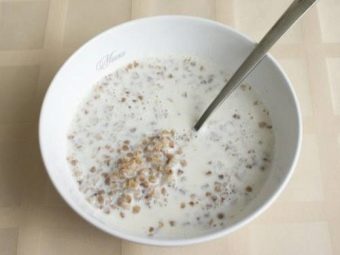
How to properly cook buckwheat while breastfeeding
A nursing mother needs to take care not only about selecting healthy products for her menu, but also about ensuring that they are prepared correctly.
Buckwheat can be prepared in the following ways:
- Garnish for meat, fish or vegetables.
- Buckwheat porridge with milk (can be made in two versions - with or without sugar).
- Buckwheat soup.
Milk buckwheat porridge is very useful for lactation. If a mother is experiencing a lack of breast milk, then such a dish must be present on her table. Preparing the porridge is quite simple: pour a glass of cereal with four glasses of milk and cook for 40 minutes. You can add a little sugar and butter to improve the taste. To prepare this dish, it is better to use aluminum or stainless steel utensils, since the porridge will definitely burn in an enamel saucepan.
Many people simply love boiled buckwheat, doused with raw milk. If you are breastfeeding, this dish is not the healthiest, as milk can cause allergies and intestinal discomfort in the baby. Therefore, only porridges where the milk is heat-treated are allowed, and the risk of allergies and colic in the child is greatly reduced. In this case, there should be enough milk so that the porridge has a fairly thick consistency, and the cereal does not float in the liquid.
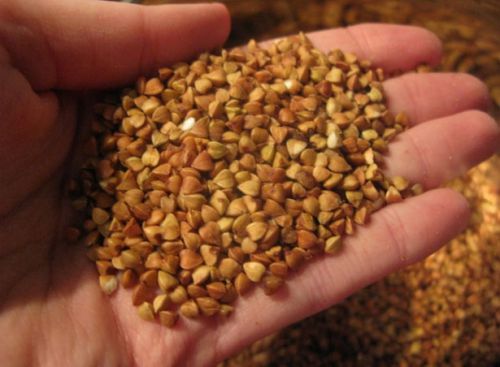
Another recipe for enhancing lactation is buckwheat, well fried in a dry frying pan, which can be eaten like seeds
Buckwheat soup will not have such a strong effect on lactation, but will take its rightful place in the diet as a hearty and tasty dish, healthy for both mother and baby. It is extremely simple to prepare. The basis of the dish is buckwheat. As a supplement, you can add any fresh or frozen vegetables, lean meats.
Correct inclusion in the diet
The main rule is that you need to introduce a new product into your diet in small portions. This is the only way to monitor the baby’s reaction.
Healthy buckwheat is introduced according to the following rules:
- start with two spoons of porridge and see if the baby has colic, bloating or an upset stomach;
- the child may not accept this product the first time, so it is worth reintroducing it after a couple of months;
- At first, porridge cooked in water is allowed, without adding butter;
- daily norm - 150-200 g;
- As the child's body grows, fresh fruits can be added.
A morning meal based on buckwheat will satiate the mother for many hours, which is why her health will always be normal.

Choice of cereals
Today on store shelves you can find various variations based on buckwheat - kernels, prodel, noodles and flakes. The right food product for a woman in the near future will be classic whole grain cereals. Other types are no less useful, but are inferior in fiber content.
Pay special attention to the condition of the packaging and expiration date. Before starting cooking, you should rinse the cereal several times to remove all particles and grinding residues. Only boiling and steaming are allowed; fried buckwheat should be excluded.
The most useful during breastfeeding is green buckwheat. Its processing did not include thermal manipulation, so the kernel retained all its richness of vitamins and minerals. True, the cost of such cereals is much higher, which is understandable. Dishes prepared from green cereals will have great benefits for the body of mother and baby.

Product Alternative
Many nursing mothers try to exclude flour products from their diet. Despite the fact that bread has high nutritional value, frequent consumption will begin to cause discomfort in the stomach, as well as weight gain.
Bread is replaced by healthy and dietary bread made from high-quality cereals. Buckwheat occupies a special place. They retain all the benefits of the cereal crop, the required level of fiber and macroelements. Unlike rye, wheat and corn, they are lower in calories.
In addition, bread is able to remove excess water, salts, toxins, and waste from the body. They have a positive effect on the newborn’s immunity, preventing frequent bloating and colic. The product does not cause allergies.
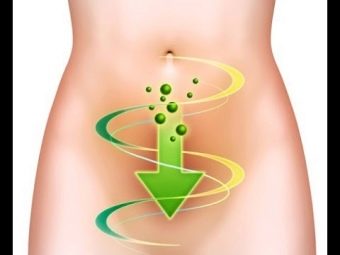
Allowed foods for a strict diet while breastfeeding
There are a number of products that almost never cause allergies or digestive problems in a baby. Nutritionists consider them to be as safe as possible and recommend adding just such food to your diet when following a strict diet.
However, it should be remembered that each baby’s digestive system has individual characteristics and even the safest product can cause a reaction. Therefore, be careful and closely monitor your child.
- Baked apples.
- White lean fish.
- Gluten-free cereals.
- Vegetable purees.
- Vegetable soups.
- Quail eggs.
- Dried fruits.
- Crackers.
- Green tea.
- Cauliflower and zucchini.
- Steamed meatballs made from lean meat.
- Dietary meat - rabbit, veal or turkey.
- Low-fat fermented milk products.
Is a buckwheat diet possible while breastfeeding?
After the birth of a child, women notice excess body weight. In an effort to lose extra pounds, a nursing mother thinks first of all about her baby. The main part of diets during breastfeeding is strictly prohibited, because it entails a deficiency of components necessary for the body. As a result, there is a risk of milk going wasted.
The lactation process itself requires a large amount of fluid, so a woman loses about 600 calories per day.
The buckwheat diet perfectly helps to reduce the size of the hips and waist, and, importantly, is completely harmless for the newborn.
According to reviews from nursing women, they managed to lose from 5 to 9 kilograms during a 2-week diet.
Such food for a certain period of time consists of buckwheat porridge, which is prepared in a special way. Pour boiling water (2 cups) over the cereal (1 cup), cover with a lid. Overnight the grains will swell and become soft. Throughout the day you eat porridge, alternating with green apples and low-fat kefir. Don't forget to drink a lot of clean water (about 2.5 liters per day).
Keep in mind that it is prohibited to practice such food restrictions in the first month of breastfeeding. As soon as the child turns six months old, you can begin to build your diet menu.
At this time, monitor lactation; if it worsens, you must stop the diet.
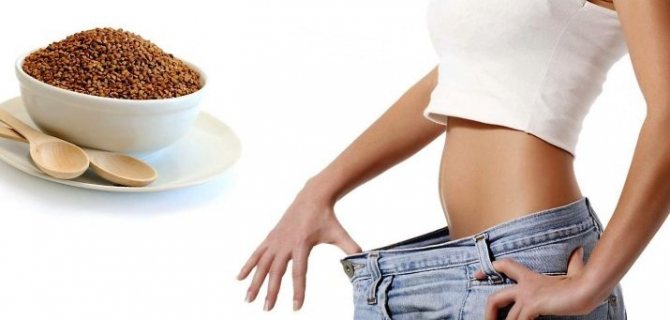
Menu for breastfeeding
| Day of the week | Breakfast | Snack | Dinner | Snack | Dinner |
| Mon | Oatmeal with apple and raisins | Green pear varieties | Seafood soup, whole grain bread | Walnuts | Steamed cutlets, salad: cucumbers, greens |
| VT | Buckwheat with milk | Whole grain bread, hard cheese | Homemade noodle and chicken soup | Rusks with raisins | Kefir |
| SR | Wheat porridge, vegetable stew (zucchini, eggplant, pepper, onion, carrot) | Baked apple, biscuits | Meatball soup | Gooseberries, cherries | Boiled fish with broccoli |
| Thu | Steam omelette, toast with cheese and herbs | Marshmallow | Buckwheat soup with beef, baked zucchini with cheese | Fruit and berry salad | Stewed cauliflower on veal |
| PT | Cottage cheese with berries | Walnuts | Chicken bouillon | Crackers | Rabbit baked in low-fat kefir, stewed vegetables |
| SB | Protein pancakes with minced meat | Kefir | Vegetable cream soup | Baked cheesecakes | Boiled chicken, lentils |
| Sun | Quail eggs, vegetable salad | Yogurt | Wheat porridge and turkey fillet soup | Bananas | Steamed meatballs, vegetables |



